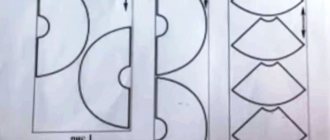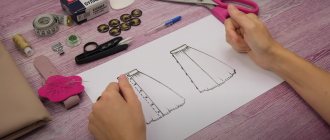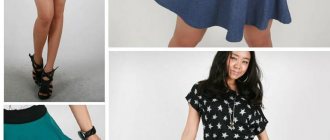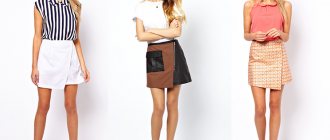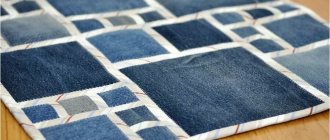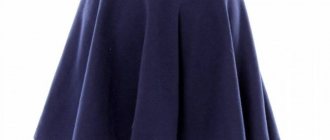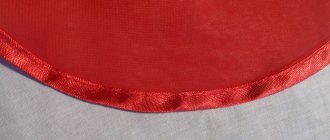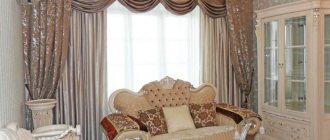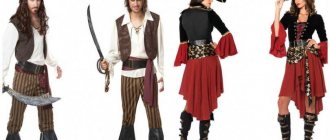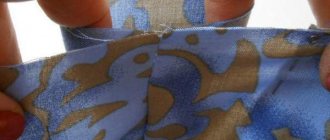A skirt with pockets in the side seams never goes out of style. A detail that seems simple affects the entire look of the product. The shape and processing technology of pockets depends on the style and properties of the fabric from which it is made. They can be located in the side seams, included in the undercut, raised line or in the seam connecting the lower part with the yoke. Today, both inconspicuous pockets in the side seams and expressive patch pockets, gathered, attracting attention with additional small details or an unusual shape are relevant.
Uncover
The first thing you need to do if you want to sew such a skirt is measure your waist. Let's call this indicator W. You also need to decide on the length of the skirt. We will further call this indicator L. Cut the fabric depending on how fluffy you want to sew the skirt.
For a very fluffy option, you will need to cut out two rectangular pieces of fabric W x 2 plus 2-2.5 cm for the seams. For a less full skirt, you will need two pieces W x 1.5.
If you are sewing a skirt from a single large piece of fabric, to determine the length when cutting, simply add 2 cm to the L indicator for the hem and 5 cm for an elastic waistband 2 cm wide. If the width of your elastic is 3 cm, add 7 cm to the length and etc. One centimeter in this case will go to the seam.
Such a skirt will look very beautiful with a strip of another fabric at the bottom, for example, 5-6 cm wide. In this case, you will need to subtract 5-6 cm from the desired length (depending on the width of the strip) and add 3.5 cm for the hem and seam allowance on the seam.
Skirt with patch pockets without a pattern: master class
This skirt is beautiful in its simplicity and comfortable. At the waist there is a drawstring with a drawstring and elastic band, so the width can be adjusted and the skirt will fit without causing discomfort, and on the front there are large patch pockets with improvised flaps with buttons.
Such a skirt can be sewn in different lengths - but it is still better not to make it shorter than an elongated mini, since there are no vents or slits, and walking in such a long skirt will be uncomfortable. If you want to make your skirt longer, add width to it.
The size can be any, from the smallest children's to adult plus sizes. The master class tells you how to calculate the parameters you need for sewing a skirt. If you want to avoid calculations and sew a skirt using the Burda pattern, study the models in the sections of patterns for women's skirts and patterns for children's skirts for girls in our electronic catalog.
For this skirt, a fabric that is not too thick is suitable - for example, thin cotton.
Follow the link to find all the master classes on sewing skirts.
Beach dress with an open back without a pattern
You will need:
- fabric for the skirt;
- elastic band 1.2 cm wide;
- tailor's scissors;
- tailor's pins;
- chalk and ruler;
- tape measure;
- a wooden stick or other device for turning out the lace;
- safety pin;
- 2 buttons;
- sewing machine and threads;
— iron and ironing board.
Idea: asymmetrical skirt without a pattern
Step 1
The skirt is sewn from two panels of the same size, front and back. To determine the sizes you need, you need to take measurements and make simple calculations.
Measure your waist circumference. Multiply the resulting value by 1.5. Make sure that the resulting measurement is a few centimeters larger than your hip circumference (especially if you have a large waist-hip difference). Divide the resulting value by 2. Add 2.4 cm - for side seam allowances of 1.2 cm.
To determine the length of your skirt, tie a drawstring around your waist and measure down to the desired length. Add 6 cm to the resulting value: 2.5 cm for the hem and 3.5 cm for the drawstring.
Cut out two identical parts.
Step 2
Find the middle line of the front panel and measure 3.5 cm from the top edge along it. From the mark down, mark a vertical loop 1.3 cm long. Make a loop and cut through it.
Summer tunic with drapery without a pattern: master class
Step 3
Place the front and back panels right sides together, align and pin the side edges together. Sew the side seams using 1.2 cm seams. Finish the seams with a zigzag stitch, for example.
Step 4
Fold the top edge 1 cm to the wrong side and iron.
Fold the top edge to the wrong side again, now 2.5 cm, and iron. Sew a stitch, stitching the hem to the edge.
Two-layer long skirt without a pattern: master class
Step 5
Cut out two pieces measuring 38x6.2 cm. Fold each strip in half with the right side inward and stitch along one short and long side with an allowance of 0.6 cm. Turn the pieces inside out and iron.
Cut an elastic length that measures 2/3 of your waist. Sew the raw ends of the ties in a zigzag pattern to the ends of the braid.
Step 6
For the pockets, cut out 4 identical pieces measuring 15x23 cm. The backside pieces of the pockets can be cut from fabric of a different color, then improvised flaps will be an additional decorative element. Place 2 pieces at a time with right sides facing inward and stitch along the perimeter, leaving an opening for turning inside out on one of the long sides. Trim the seams at the corners.
Turn the pieces inside out, straighten the seams and iron.
How to sew a knitted pencil skirt without a pattern in 30 minutes: master class + video
Step 7
Fold the top outer corners of the pockets outwards and iron them. You can make buttonholes or sew buttons directly to the pocket and improvised flap.
Step 8
Turn the skirt right side out. Mark the locations of the pockets parallel to the side seams, 2.5 cm from them and under the drawstring seam. Pin the pockets and stitch to the cuffs as shown in the diagram.
Step 9
Turn the skirt inside out. Fold the bottom edge twice by 1.2 cm, iron it and secure the fold with a stitch.
Step 10
Thread the drawstring tie through the hole using a safety pin. Ready.
Photo and source: mellysews.com
Stole kimono without pattern: master class
Pockets and stripe
Place the first rectangle of the skirt in front of you. Step back 12-15 cm from the top. Place the cut pocket in this place as shown in the photo below. Place the pieces face to face. Secure the pocket with a basting stitch and iron the pieces.
Attach a strip of another fabric at the bottom. Iron everything in the same way.
Sew the strip to the skirt. Finish the edge with a zigzag stitch or overlock stitch.
Rare shot: Viktoria Isakova showed her grown-up daughter from Yuri Moroz (new photo)
Smooth and fresh skin: dermaplaning, or why a woman needs to shave her face
“We are still friends”: Derevianko commented on the breakup with his wife
Bend it down and additionally sew the seam, departing from the fold by 1-2 mm, so that it looks neat.
Do the same operations with the second part of the pocket and the strip with the second rectangle.
Classic shapes
Every woman should have a straight skirt in her wardrobe. It is suitable for both business meetings and everyday wear. However, a plain, especially black, straight-cut skirt without any trim looks boring. Paired with a white blouse is considered dress code for service personnel. For office style, it is convenient with cut-off barrels or patch pockets. They can be rectangular, oval, even pentagonal, stitched at the edge or at some distance from it.
Skillfully selected clothes will correct your figure. Fashionable straight skirts with pockets on the sides, trimmed along the seams with flounce, lace or fur, visually enlarge the hips. For a plump girl, it is better to purchase one with a high waist. The patch pocket-briefcase looks sporty. Set-in finishing elements look impressive on striped or checkered fabrics if the pattern on them is located at a certain angle to the corresponding pattern of the main part of the product. On summer skirts made of printed fabrics, simple patch pockets are hardly noticeable.
On products with longitudinal shaped lines, they are placed between them and the side seam. Often this item of clothing is complemented with a flap. Feminine, fitted pencil skirts have pockets hidden in the side seams. Products with a camouflage print, formalistic military, are equipped with pockets with buttons. The tighter the product is, the higher the front slit.
Sewing a skirt: instructions
Place the first and second rectangle on a flat surface in front of you, face to face. Pin the pieces together where seams should be, or use a basting stitch. Connect the sides of the skirt and the edges of the pocket.
Sew the side of the skirt along the edge, retreating 1-1.5 cm. At the location of the pocket, go around the hole, sewing along the edge of the pocket itself. Perform the same operation on the other side.
"Dad is offended." Agata Muceniece about her relationship with Priluchny after the divorce
Lost weight: what Sofia Tarasova sacrificed for the sake of “VIA Gra” (new photos)
A Brazilian travels 36 km by bike every day to take his loved one home.
In the next step, hem the strip sewn at the bottom. Fold the edge 1 cm, iron and fold another 1 cm. Press and sew the seam again.
Skirt top
Now it's time to finish sewing the top of the skirt. Fold the top edge of the skirt and iron it. Fold the raw edge inward 1 cm and iron everything. Make a seam, leaving an opening for the elastic to pass through.
Take the elastic and thread it inside the fold. Make a fitting, cut the elastic to the desired length and sew its edges. Sew the elastic not with a regular seam, but with a zigzag seam. At the same time, for reliability, secure the end and beginning of the seam using the forward/backward method.
At the final stage, sew up the hole through which you passed the elastic. It can be sewn directly from the face.
At this point, the process of sewing a skirt can be considered complete. This product can be worn, for example, when going on a visit to surprise friends, to the beach, or just to the store.
Found a violation? Report content
Curvy and asymmetrical
A circle skirt is more suitable for a slender girl and will emphasize her thin waist. They are sewn not from one solid piece of fabric, but from several wedges, but when unfolded they still have the shape of a circle. The upper part can end with an elastic band, a yoke or a corsage belt, making the figure proportional. The optimal length is midi. Thin fabric can be gathered before joining the belt. The asymmetrical sun style is shortened at the front and has a train almost to the floor at the back. The flared style will suit everyone if you choose the right texture, fabric pattern and determine its initial level (½, ¼ sun). The product does not hug the figure and hides fullness. A flared circle skirt is sewn with pockets in the side seams, the shape of the burlap may vary.
Light and bright flowing pleated fabrics - pleated and ruffled - are popular this season for floor-length summer skirts with pockets, suitable for slender girls. A long skirt with patch pockets and soft folds will hide extra pounds. Often the pockets on such models are located along the side seams, and the product is often placed on a lining. Summer pleated skirts with patch pockets that stand out in size are fashionable. They not only fulfill their intended purpose, but also serve as decoration. The ruffles can be soft or pressed, gathered in different directions, but they always look lush.
In addition to those listed, multi-tiered, tutu, Tatyanka, and American are popular. Sewn from light natural and artificial fabrics. Linen, chintz, guipure, crepe de Chine, and chiffon are suitable for this. They must allow air to pass through well. A pleated skirt with pockets located on the yoke will emphasize the waist. From the abundance of skirt models offered by the industry, any woman will choose for herself a product of the desired length and style, which is equipped with pockets that decorate the clothes.
